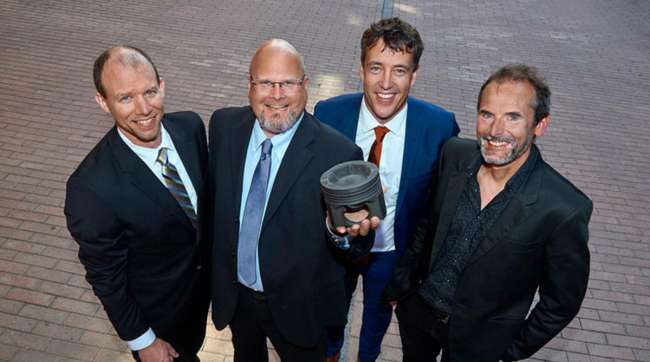Senior Reporter
Designers of Wave Piston Win 2017 Volvo Group Technology Award

Volvo Group awarded its 2017 Volvo Technology Award to the two engineers for their piston design, which added “waves” to the piston crown to improve the use of oxygen, thereby increasing fuel efficiency and reducing particulate matter in its heavy-duty engines.
The patented design is a new wrinkle for the internal combustion engine that has been in existence for 140 years, Volvo Group said.
“For heavy vehicles, diesel engine technology will be important for many more years to come,” Lars Stenqvist, Volvo Group’s chief technology officer, said in a statement. “I am proud of our engineers who have once again shown that innovative solutions can still make engines more efficient for the benefit of our customers and of society as a whole.”
In use in the latest D11 and D13 Class 8 engines, the new design has “halved the quantity of soot particles emitted by the engines and has also reduced fuel consumption by an average of 2%,” the manufacturer said.
The development of the wave piston — as well as turbo compounding and a common rail fuel injection system — was supported by the SuperTruck cost-sharing program, sponsored by the U.S. Department of Energy, Volvo Trucks North America, a unit of Volvo Group, said.
To prove that their initial ideas were correct and to determine the exact design of the piston crown, company engineers Jan Eismark and Michael Balthasar used computational fluid dynamics and filmed the combustion process inside the cylinder at high speed, Sweden-based Volvo Group said.
In the case of a standard piston, the injector is located at the top of the cylinder and the fuel is sprayed toward the sides of the cylinder through a number of orifices in the injector, the manufacturer said
The combination of heat and pressure causes the fuel to ignite before it reaches the cylinder wall, the Volvo Group said.
The flame hits the wall of the combustion chamber at a speed of up to 50 meters per second, spreads along the piston bowl wall and then collides with adjacent flames at an angle of 180 degrees, while still traveling at a high speed, according to Volvo Group.
When the flames collide, they compete for the available oxygen. At the same time, the oxygen in the center of the combustion chamber is never fully used, the group said.
“For this reason, we wanted to identify a method of leading the flames into the center of the combustion chamber to make better use of the oxygen there,” Eismark said in a statement.
The result of their work was the inclusion of ridges or waves in the piston crown. The piston has six of these ridges and the injector, which is located in the center of the cylinder at the top of the piston, and has six orifices to ensure the fuel is sprayed between the ridges that lead the flames into the center, Volvo Group said.
Before the new design could find its niche in everyday use, Volvo Group said it had to develop the piston manufacturing methods to achieve the right balance between the cost of the parts and the benefits for customers; that was followed by thousands of hours of testing to refine the design and verify the durability of the new concept.
VTNA had a year-to-date market share of 9.6% of U.S. retail sales of Class 8 trucks through May, according to WardsAuto.com. That was up from a 9.4% share in the same 2016 period.




